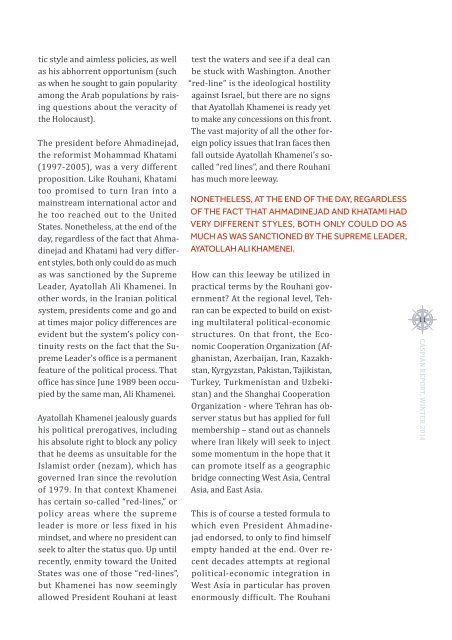Caspian Report - Issue 06 - Winter 2014
Create successful ePaper yourself
Turn your PDF publications into a flip-book with our unique Google optimized e-Paper software.
tic style and aimless policies, as well<br />
as his abhorrent opportunism (such<br />
as when he sought to gain popularity<br />
among the Arab populations by raising<br />
questions about the veracity of<br />
the Holocaust).<br />
The president before Ahmadinejad,<br />
the reformist Mohammad Khatami<br />
(1997-2005), was a very different<br />
proposition. Like Rouhani, Khatami<br />
too promised to turn Iran into a<br />
mainstream international actor and<br />
he too reached out to the United<br />
States. Nonetheless, at the end of the<br />
day, regardless of the fact that Ahmadinejad<br />
and Khatami had very different<br />
styles, both only could do as much<br />
as was sanctioned by the Supreme<br />
Leader, Ayatollah Ali Khamenei. In<br />
other words, in the Iranian political<br />
system, presidents come and go and<br />
at times major policy differences are<br />
evident but the system’s policy continuity<br />
rests on the fact that the Supreme<br />
Leader’s office is a permanent<br />
feature of the political process. That<br />
office has since June 1989 been occupied<br />
by the same man, Ali Khamenei.<br />
Ayatollah Khamenei jealously guards<br />
his political prerogatives, including<br />
his absolute right to block any policy<br />
that he deems as unsuitable for the<br />
Islamist order (nezam), which has<br />
governed Iran since the revolution<br />
of 1979. In that context Khamenei<br />
has certain so-called “red-lines,” or<br />
policy areas where the supreme<br />
leader is more or less fixed in his<br />
mindset, and where no president can<br />
seek to alter the status quo. Up until<br />
recently, enmity toward the United<br />
States was one of those “red-lines”,<br />
but Khamenei has now seemingly<br />
allowed President Rouhani at least<br />
test the waters and see if a deal can<br />
be stuck with Washington. Another<br />
“red-line” is the ideological hostility<br />
against Israel, but there are no signs<br />
that Ayatollah Khamenei is ready yet<br />
to make any concessions on this front.<br />
The vast majority of all the other foreign<br />
policy issues that Iran faces then<br />
fall outside Ayatollah Khamenei’s socalled<br />
“red lines”, and there Rouhani<br />
has much more leeway.<br />
NONETHELESS, AT THE END OF THE DAY, REGARDLESS<br />
OF THE FACT THAT AHMADINEJAD AND KHATAMI HAD<br />
VERY DIFFERENT STYLES, BOTH ONLY COULD DO AS<br />
MUCH AS WAS SANCTIONED BY THE SUPREME LEADER,<br />
AYATOLLAH ALI KHAMENEI.<br />
How can this leeway be utilized in<br />
practical terms by the Rouhani government<br />
At the regional level, Tehran<br />
can be expected to build on existing<br />
multilateral political-economic<br />
structures. On that front, the Economic<br />
Cooperation Organization (Afghanistan,<br />
Azerbaijan, Iran, Kazakhstan,<br />
Kyrgyzstan, Pakistan, Tajikistan,<br />
Turkey, Turkmenistan and Uzbekistan)<br />
and the Shanghai Cooperation<br />
Organization - where Tehran has observer<br />
status but has applied for full<br />
membership – stand out as channels<br />
where Iran likely will seek to inject<br />
some momentum in the hope that it<br />
can promote itself as a geographic<br />
bridge connecting West Asia, Central<br />
Asia, and East Asia.<br />
This is of course a tested formula to<br />
which even President Ahmadinejad<br />
endorsed, to only to find himself<br />
empty handed at the end. Over recent<br />
decades attempts at regional<br />
political-economic integration in<br />
West Asia in particular has proven<br />
enormously difficult. The Rouhani<br />
11<br />
CASPIAN REPORT, WINTER <strong>2014</strong>










